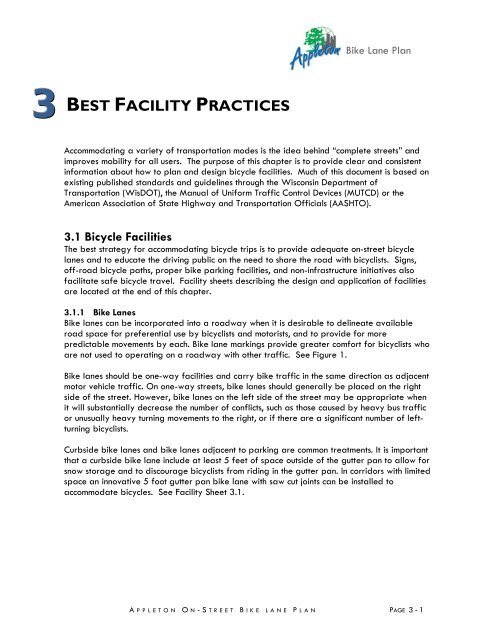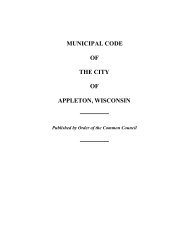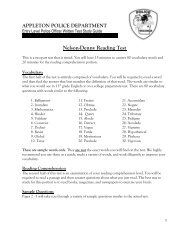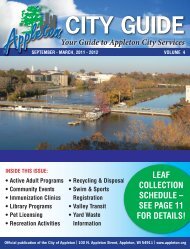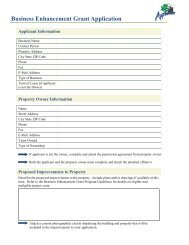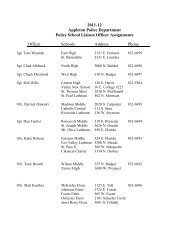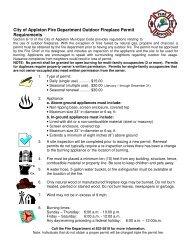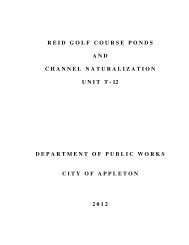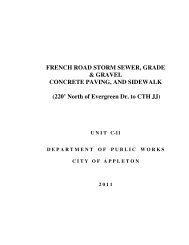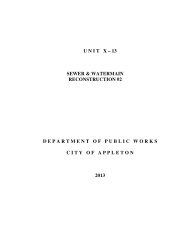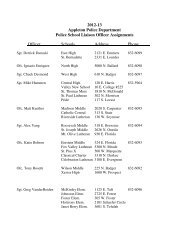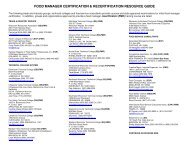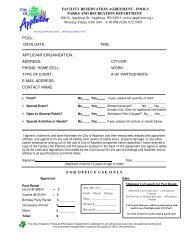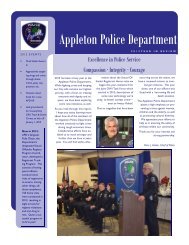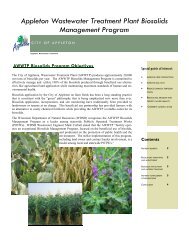City of Appleton On-Street Bike Lane Plan
City of Appleton On-Street Bike Lane Plan
City of Appleton On-Street Bike Lane Plan
Create successful ePaper yourself
Turn your PDF publications into a flip-book with our unique Google optimized e-Paper software.
3<br />
BEST FACILITY PRACTICES<br />
<strong>Bike</strong> <strong>Lane</strong> <strong>Plan</strong><br />
Accommodating a variety <strong>of</strong> transportation modes is the idea behind “complete streets” and<br />
improves mobility for all users. The purpose <strong>of</strong> this chapter is to provide clear and consistent<br />
information about how to plan and design bicycle facilities. Much <strong>of</strong> this document is based on<br />
existing published standards and guidelines through the Wisconsin Department <strong>of</strong><br />
Transportation (WisDOT), the Manual <strong>of</strong> Uniform Traffic Control Devices (MUTCD) or the<br />
American Association <strong>of</strong> State Highway and Transportation Officials (AASHTO).<br />
3.1 Bicycle Facilities<br />
The best strategy for accommodating bicycle trips is to provide adequate on-street bicycle<br />
lanes and to educate the driving public on the need to share the road with bicyclists. Signs,<br />
<strong>of</strong>f-road bicycle paths, proper bike parking facilities, and non-infrastructure initiatives also<br />
facilitate safe bicycle travel. Facility sheets describing the design and application <strong>of</strong> facilities<br />
are located at the end <strong>of</strong> this chapter.<br />
3.1.1 <strong>Bike</strong> <strong>Lane</strong>s<br />
<strong>Bike</strong> lanes can be incorporated into a roadway when it is desirable to delineate available<br />
road space for preferential use by bicyclists and motorists, and to provide for more<br />
predictable movements by each. <strong>Bike</strong> lane markings provide greater comfort for bicyclists who<br />
are not used to operating on a roadway with other traffic. See Figure 1.<br />
<strong>Bike</strong> lanes should be one-way facilities and carry bike traffic in the same direction as adjacent<br />
motor vehicle traffic. <strong>On</strong> one-way streets, bike lanes should generally be placed on the right<br />
side <strong>of</strong> the street. However, bike lanes on the left side <strong>of</strong> the street may be appropriate when<br />
it will substantially decrease the number <strong>of</strong> conflicts, such as those caused by heavy bus traffic<br />
or unusually heavy turning movements to the right, or if there are a significant number <strong>of</strong> leftturning<br />
bicyclists.<br />
Curbside bike lanes and bike lanes adjacent to parking are common treatments. It is important<br />
that a curbside bike lane include at least 5 feet <strong>of</strong> space outside <strong>of</strong> the gutter pan to allow for<br />
snow storage and to discourage bicyclists from riding in the gutter pan. In corridors with limited<br />
space an innovative 5 foot gutter pan bike lane with saw cut joints can be installed to<br />
accommodate bicycles. See Facility Sheet 3.1.<br />
A PPLETON O N -STREET B IKE LANE P LAN PAGE 3 - 1


